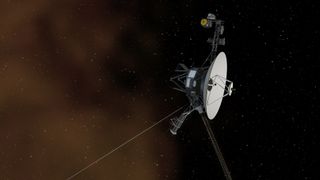Celebrate NASA's Voyager missions at 45 with this free webcast tonight
NASA's 45th anniversary Voyager mission webcast will begin at 7 p.m. PDT (10 p.m. EDT/0200 GMT).
NASA's Voyager probes to interstellar space are icons of cosmic exploration, and you can celebrate their 45th anniversary with a free science webcast tonight (Aug. 18).
The space agency's Jet Propulsion Laboratory (JPL) in Pasadena, California will host a live lecture tonight at 7 p.m. PDT (10 p.m. EDT, 0200 GMT) to showcase the Voyager mission, which launched two spacecraft toward the outer solar system in 1977. The first of those to launch, Voyager 2, lifted off 45 years ago this weekend.
Related: Celebrate 45 years of Voyager with amazing solar system images (gallery)

Brian White of JPL's Public Services Office will host the webcast, which will feature Voyager project manager Suzanne Dodd and be co-hosted by JPL spokesperson Calla Cofield. You can watch it in the live feed above or directly from JPL's YouTube channel.
"As the twin Voyager spacecraft approach their 45th anniversary, we take a look at where the mission has been, what they've taught us and where they go from here," JPL officials said in an announcement. "In this conversation with Suzanne Dodd, Voyager Project Manager, we’ll discuss how Voyager came to be, highlight some of the major discoveries, and hear stories about this mission that has captured the public’s attention for years."
NASA launched Voyager 2 on Aug. 20, 1977, with the Voyager 1 mission following a few weeks later on Sept. 5. The twin spacecraft sailed on a tour of the outer planets, with Voyager 2 visiting Jupiter, Saturn, Uranus and Neptune. Voyager 1, meanwhile, flew by Jupiter and Saturn.
The two spacecraft captured stunning close-up images of the outer planets, with Voyager 1 snapping the famed "Pale Blue Dot" image of Earth as seen from a distance of 3.7 billion miles (6 billion kilometers) from the sun. The image, which shows all of humanity as a faint blue speck in the dark void of space, became an icon of exploration and the vastness of the cosmos.
Get the Space.com Newsletter
Breaking space news, the latest updates on rocket launches, skywatching events and more!
In 2012, Voyager 1 made history when it became the first spacecraft to enter interstellar space. Voyager 2 followed suit in December 2018. The two spacecraft are the farthest human-built objects in space and NASA's longest-running space missions in history.
Email Tariq Malik at tmalik@space.com or follow him @tariqjmalik. Follow us @Spacedotcom, Facebook and Instagram.
Join our Space Forums to keep talking space on the latest missions, night sky and more! And if you have a news tip, correction or comment, let us know at: community@space.com.

Tariq is the Editor-in-Chief of Space.com and joined the team in 2001, first as an intern and staff writer, and later as an editor. He covers human spaceflight, exploration and space science, as well as skywatching and entertainment. He became Space.com's Managing Editor in 2009 and Editor-in-Chief in 2019. Before joining Space.com, Tariq was a staff reporter for The Los Angeles Times covering education and city beats in La Habra, Fullerton and Huntington Beach. In October 2022, Tariq received the Harry Kolcum Award for excellence in space reporting from the National Space Club Florida Committee. He is also an Eagle Scout (yes, he has the Space Exploration merit badge) and went to Space Camp four times as a kid and a fifth time as an adult. He has journalism degrees from the University of Southern California and New York University. You can find Tariq at Space.com and as the co-host to the This Week In Space podcast with space historian Rod Pyle on the TWiT network. To see his latest project, you can follow Tariq on Twitter @tariqjmalik.
